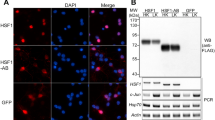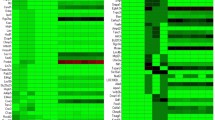Abstract
The heat shock protein (Hsp) system is a cell defense mechanism constitutively expressed at the basal state and essential for cell survival in response to damaging stimuli. Apoptosis is a physiological cell death program that preserves tissue homeostasis. We investigated the intrinsic pathway of apoptosis at various stages of brain maturation in CD-1 mice, triggered by two mitochondrial proapoptotic proteins, cytochrome c and Smac/DIABLO, and the pathway’s regulation by Hsp-70. Smac/DIABLO and Hsp-70 proteins were upregulated 2-fold and 1.5–3-fold, respectively, after birth. In contrast, in the presence of cytochrome c/2′-deoxyadenosine 5′-triphosphate (dATP), caspase activity in mouse brain cell-free extracts increased 90-fold and 61-fold, at fetal and neonatal stages, whereas no activation was detected 15 days postnatally or at any subsequent times. These results indicate that the activation pattern of the intrinsic pathway of apoptosis undergoes a marked shift during postnatal maturation.




Similar content being viewed by others
References
Adrain, C., Creagh, E. M., & Martin, S. J. (2001). Apoptosis-associated release of Smac/DIABLO from mitochondria requires active caspases and is blocked by Bcl-2. EMBO Journal, 20, 6627–6636.
Arnoult, D., Gaume, B., Karbowski, M., et al. (2003). Mitochondrial release of AIF and EndoG requires caspase activation downstream of Bax/Bak-mediated permeabilization. EMBO Journal, 22, 4385–4399.
Bartling, B., Lewensohn, R., & Zhivotovsky, B. (2004). Endogenously released Smac is insufficient to mediate cell death of human lung carcinoma in response to etoposide. Experimental Cell Research, 298, 83–95.
Beere, H. M. (2004). “The stress of dying”: The role of heat shock proteins in the regulation of apoptosis. Journal of Cell Science, 117, 2641–2651.
Beere, H. M., Wolf, B. B., Cain, K., et al. (2000). Heat-shock protein 70 inhibits apoptosis by preventing recruitment of procaspase-9 to the Apaf-1 apoptosome. Nature Cell Biology, 2, 469–475.
Carson, J. P., Behnam, M., Sutton, J. N., et al. (2002). Smac is required for cytochrome c-induced apoptosis in prostate cancer LNCaP cells. Cancer Research, 62, 18–23.
Chauhan, D., Hideshima, T., Rosen, S., et al. (2001). Apaf-1/cytochrome c-independent and Smac-dependent induction of apoptosis in multiple myeloma (MM) cells. Journal of Biological Chemistry, 276, 24453–24456.
Creagh, E. M., Murphy, B. M., Duriez, P. J., et al. (2004). Smac/Diablo antagonizes ubiquitin ligase activity of inhibitor of apoptosis proteins. Journal of Biological Chemistry, 279, 26906–26914.
Deshmukh, M., Du, C., Wang, X., & Johnson, E. M. Jr. (2002). Exogenous smac induces competence and permits caspase activation in sympathetic neurons. Journal of Neuroscience, 22, 8018–8027.
Dirsch, V. M., Muller, I. M., Eichhorst, S. T., et al. (2003). Cephalostatin 1 selectively triggers the release of Smac/DIABLO and subsequent apoptosis that is characterized by an increased density of the mitochondrial matrix. Cancer Research, 63, 8869–8876.
Du, C., Fang, M., Li, Y., et al. (2000). Smac, a mitochondrial protein that promotes cytochrome c-dependent caspase activation by eliminating IAP inhibition. Cell, 102, 33–42.
Ekert, P. G., & Vaux, D. L. (2005). The mitochondrial death squad: Hardened killers or innocent bystanders? Current Opinion in Cell Biology, 17, 626–630.
Ferri, K. F., & Kroemer, G. (2001). Organelle-specific initiation of cell death pathways. Nature Cell Biology, 3, E255–E263.
Garrido, C., Bruey, J. M., Fromentin, A., et al. (1999). HSP27 inhibits cytochrome c-dependent activation of procaspase-9. FASEB Journal, 13, 2061–2070.
Gutsmann-Conrad, A., Heydari, A. R., You, S., & Richardson, A. (1998). The expression of heat shock protein 70 decreases with cellular senescence in vitro and in cells derived from young and old human subjects. Experimental Cell Research, 241, 404–413.
Gutsmann-Conrad, A., Pahlavani, M. A., Heydari, A. R., & Richardson, A. (1999). Expression of heat shock protein 70 decreases with age in hepatocytes and splenocytes from female rats. Mechanisms of Ageing and Development, 107, 255–270.
Hansen, T. M., Smith, D. J., & Nagley, P. (2006). Smac/DIABLO is not released from mitochondria during apoptotic signalling in cells deficient in cytochrome c. Cell Death and Differentiation, 13, 1181–1190.
Hu, X. L., Olsson, T., Johansson, I. M., et al. (2004). Dynamic changes of the anti- and pro-apoptotic proteins Bcl-w, Bcl-2, and Bax with Smac/Diablo mitochondrial release after photothrombotic ring stroke in rats. European Journal of Neuroscience, 20, 1177–1188.
Hunter, A. M., Kottachchi, D., Lewis, J., et al. (2003). A novel ubiquitin fusion system bypasses the mitochondria and generates biologically active Smac/DIABLO. Journal of Biological Chemistry, 278, 7494–7499.
Jin, Z., & El-Deiry, W. S. (2005). Overview of cell death signaling pathways. Cancer Biology and Therapy, 4, 139–163.
Kandasamy, K., Srinivasula, S. M., Alnemri, E. S., et al. (2003). Involvement of proapoptotic molecules Bax and Bak in tumor necrosis factor-related apoptosis-inducing ligand (TRAIL)-induced mitochondrial disruption and apoptosis: Differential regulation of cytochrome c and Smac/DIABLO release. Cancer Research, 63, 1712–1721.
Kiang, J. G., & Tsokos, G. C. (1998). Heat shock protein 70 kDa: Molecular biology, biochemistry, and physiology. Pharmacological Therapy, 80, 183–201.
Kuan, C. Y., Roth, K. A., Flavell, R. A., & Rakic, P. (2000). Mechanisms of programmed cell death in the developing brain. Trends in Neuroscience, 23, 291–297.
Li, P., Nijhawan, D., Budihardjo, I., et al. (1997). Cytochrome c and dATP-dependent formation of Apaf-1/caspase-9 complex initiates an apoptotic protease cascade. Cell, 91, 479–489.
Liu, X., Kim, C. N., Yang, J., et al. (1996). Induction of apoptotic program in cell-free extracts: Requirement for dATP and cytochrome c. Cell, 86, 147–157.
Lotocki, G., Alonso, O. F., Frydel, B., et al. (2003). Monoubiquitination and cellular distribution of XIAP in neurons after traumatic brain injury. Journal of Cerebral Blood Flow and Metabolism, 23, 1129–1136.
Maiello, M., Boeri, D., Sampietro, L. et al. (1998). Basal synthesis of heat shock protein 70 increases with age in rat kidneys. Gerontology, 44, 15–20.
McArdle, A., Dillmann, W. H., Mestril, R., et al. (2004). Overexpression of HSP-70 in mouse skeletal muscle protects against muscle damage and age-related muscle dysfunction. FASEB Journal, 18, 355–357.
Moore, S. A., Lopez, A., Richardson, A., & Pahlavani, M. A. (1998). Effect of age and dietary restriction on expression of heat shock protein 70 in rat alveolar macrophages. Mechanisms of Ageing and Development, 104, 59–73.
Okada, H., Suh, W. K., Jin, J., et al. (2002). Generation and characterization of Smac/DIABLO-deficient mice. Molecular and Cellular Biology, 22, 3509–3517.
Ota, K., Yakovlev, A. G., Itaya, A., et al. (2002). Alteration of apoptotic protease-activating factor-1 (APAF-1)-dependent apoptotic pathway during development of rat brain and liver. Journal of Biochemistry (Tokyo), 131, 131–135.
Pandey, P., Farber, R., Nakazawa, A., et al. (2000). Hsp27 functions as a negative regulator of cytochrome c-dependent activation of procaspase-3. Oncogene, 19, 1975–1981.
Rehm, M., Dussmann, H., & Prehn, J. H. (2003). Real-time single cell analysis of Smac/DIABLO release during apoptosis. Journal of Cell Biology, 162, 1031–1043.
Saito, A., Hayashi, T., Okuno, S. et al. (2003). Interaction between XIAP and Smac/DIABLO in the mouse brain after transient focal cerebral ischemia. Journal of Cerebral Blood Flow and Metabolism, 23, 1010–1019.
Saito, A., Hayashi, T., Okuno, S., et al. (2004). Oxidative stress is associated with XIAP and Smac/DIABLO signaling pathways in mouse brains after transient focal cerebral ischemia. Stroke, 35, 1443–1448.
Saleh, A., Srinivasula, S. M., Acharya, S., et al. (1999). Cytochrome c and dATP-mediated oligomerization of Apaf-1 is a prerequisite for procaspase-9 activation. Journal of Biological Chemistry, 274, 17941–17945.
Saleh, A., Srinivasula, S. M., Balkir, L., et al. (2000). Negative regulation of the Apaf-1 apoptosome by Hsp-70. Nature Cell Biology, 2, 476–483.
Shibata, M., Hattori, H., Sasaki, T. et al. (2002). Subcellular localization of a promoter and an inhibitor of apoptosis (Smac/DIABLO and XIAP) during brain ischemia/reperfusion. Neuroreports, 13, 1985–1988.
Shigenaga, M. K., Hagen, T. M., & Ames, B. N. (1994). Oxidative damage and mitochondrial decay in aging. Proceedings of the National Academy of Sciences USA, 91, 10771–10778.
Shiozaki, E. N., & Shi, Y. (2004). Caspases, IAPs and Smac/DIABLO: Mechanisms from structural biology. Trends in Biochemical Sciences, 29, 486–494.
Siegelin, M., Touzani, O., Toutain, J., et al. (2005a). Induction and redistribution of XAF1, a new antagonist of XIAP in the rat brain after transient focal ischemia. Neurobiology of Disease, 20, 509–518.
Siegelin, M. D., Kossatz, L. S., Winckler, J., & Rami, A. (2005b). Regulation of XIAP and Smac/DIABLO in the rat hippocampus following transient forebrain ischemia. Neurochemistry International, 46, 41–51.
Skulachev, V. P. (2001). The programmed death phenomena, aging, and the Samurai law of biology. Experimental Gerontology, 36, 995–1024.
Srinivasula, S. M., Datta, P., Fan, X. J., et al. (2000). Molecular determinants of the caspase-promoting activity of Smac/DIABLO and its role in the death receptor pathway. Journal of Biological Chemistry, 275, 36152–36157.
Srinivasula, S. M., Hegde, R., Saleh, A., et al. (2001). A conserved XIAP-interaction motif in caspase-9 and Smac/DIABLO regulates caspase activity and apoptosis. Nature, 410, 112–116.
Stoka, V., Chen, S. F., Turk, V., & Bredesen, D. E. (2005). Developmental shift in the apostat: Comparison of neurones and astrocytes. FEBS Letters, 579, 6147–6150.
Stoka, V., Turk, V., & Bredesen, D. E. (2006). Differential regulation of the intrinsic pathway of apoptosis in brain and liver during ageing. FEBS Letters, 580, 3739–3745.
Sugawara, T., Noshita, N., Lewen, A. et al. (2002). Overexpression of copper/zinc superoxide dismutase in transgenic rats protects vulnerable neurons against ischemic damage by blocking the mitochondrial pathway of caspase activation. Journal of Neuroscience, 22, 209–217.
Takai, D., Inoue, K., Shisa, H. et al. (1995). Age-associated changes of mitochondrial translation and respiratory function in mouse brain. Biochemical and Biophysical Research Communications, 217, 668–674.
Tanaka, H., Yokota, H., Jover, T. et al. (2004). Ischemic preconditioning: Neuronal survival in the face of caspase-3 activation. Journal of Neuroscience, 24, 2750–2759.
Tandara, A. A., Kloeters, O., Kim, I., et al. (2006). Age effect on HSP-70: Decreased resistance to ischemic and oxidative stress in HDF. The Journal of Surgical Research, 132, 32–39.
van Loo, G., Saelens, X., van Gurp, M., et al. (2002). The role of mitochondrial factors in apoptosis: A Russian roulette with more than one bullet. Cell Death Differentiation, 9, 1031–1042.
Verhagen, A. M., Ekert, P. G., Pakusch, M., et al. (2000). Identification of DIABLO, a mammalian protein that promotes apoptosis by binding to and antagonizing IAP proteins. Cell, 102, 43–53.
Verhagen, A. M., Silke, J., Ekert, P. G., et al. (2002). HtrA2 promotes cell death through its serine protease activity and its ability to antagonize inhibitor of apoptosis proteins. Journal of Biological Chemistry, 277, 445–454.
Yao, M., Nguyen, T. V., & Pike, C. J. (2005). Beta-amyloid-induced neuronal apoptosis involves c-Jun N-terminal kinase-dependent downregulation of Bcl-w. Journal of Neuroscience, 25, 1149–1158.
Yin, K. J., Lee, J. M., Chen, S. D., et al. (2002). Amyloid-beta induces Smac release via AP-1/Bim activation in cerebral endothelial cells. Journal of Neuroscience, 22, 9764–9770.
Yakovlev, A. G., Ota, K., Wang, G., et al. (2001). Differential expression of apoptotic protease-activating factor-1 and caspase-3 genes and susceptibility to apoptosis during brain development and after traumatic brain injury. Journal of Neuroscience, 21, 7439–7446.
Zhou, L. L., Zhou, L. Y., Luo, K. Q., & Chang, D. C. (2005). Smac/DIABLO and cytochrome c are released from mitochondria through a similar mechanism during UV-induced apoptosis. Apoptosis, 10, 289–299.
Zhu, C., Wang, X., Xu, F., et al. (2005). The influence of age on apoptotic and other mechanisms of cell death after cerebral hypoxia-ischemia. Cell Death Differentiation, 12, 162–176.
Zou, H., Li, Y., Liu, X., & Wang, X. (1999). An APAF-1 cytochrome c multimeric complex is a functional apoptosome that activates procaspase-9. Journal of Biological Chemistry, 274, 11549–11556.
Acknowledgments
The authors are thankful to Sylvia F. Chen for technical assistance during brain tissue preparation. This study was supported by NIH grants AG12282 and NS33376 to D.E.B. and grant P1-0140 from the Ministry of Higher Education, Science and Technology of the Republic of Slovenia to V.T.
Author information
Authors and Affiliations
Corresponding author
Additional information
Vito Turk and Dale E. Bredesen share senior authorship.
Rights and permissions
About this article
Cite this article
Stoka, V., Turk, V. & Bredesen, D.E. Differential Regulation of Smac/DIABLO and Hsp-70 during Brain Maturation. Neuromol Med 9, 255–263 (2007). https://doi.org/10.1007/s12017-007-8007-9
Received:
Accepted:
Published:
Issue Date:
DOI: https://doi.org/10.1007/s12017-007-8007-9




